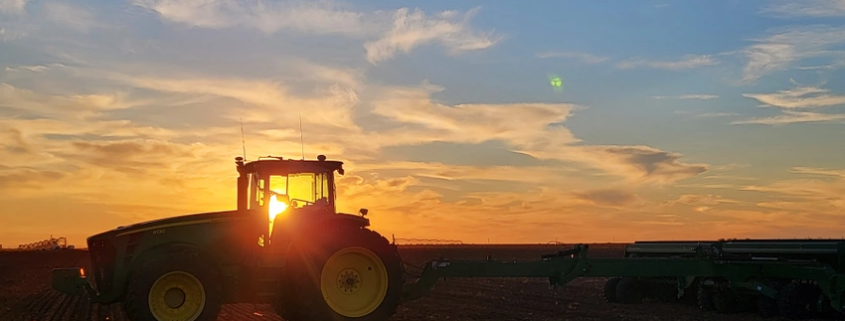Tractor accidents No. 1 factor in farm-related fatalities
The leading cause of work-related fatalities to farmers and farm workers is transportation incidents, including tractor rollovers and roadway collisions.
Innovation in farm equipment stands as one of the most significant changes in the agriculture landscape over this reporter’s four-decade career as a farm writer.
From open-air tractors, pull-behind harvesters, and narrow tillage equipment, farm machinery has evolved into larger, more powerful, and safer units.
Global Positioning System (GPS) operations, air-conditioned cabs, and on-board computers are now standard equipment.
Still, farm incidents happen. Machinery failure, unexpected obstacles, and human error may result in serious injury, even death. Even with the latest GPS equipment, the driver remains the most important part of the operation.
The Southwest Center for Agricultural Health, Injury Prevention, and Education, located at The University of Texas at Tyler Health Science Center, provides guidelines on tractor and other farm equipment safety.
“Transportation incidents, including tractor rollovers and roadway collisions, are the leading cause of work-related fatalities to farmers and farm workers,” says SW Ag Center Program Director Amanda Wickman.
“Tractors and equipment are also the source of many traumatic injuries. Many of these incidents can be prevented by simply slowing down and taking a few commonsense precautions, including turning off equipment before dismounting and performing repairs, replacing broken guards and shields, and keeping safety features intact.”
Behavior choices
Wickman says many safety and health precautions come down to personal behavior choices. “A farmer’s job is never done and they are constantly striving to be as productive as possible. It is our job to remind them that performing a task safely may take a few extra moments, but it could prevent a costly injury or fatality. Not only that, farmers are role models for the next generation of agricultural producers. Their children and grandchildren will follow in their footsteps.”
Education and training
Along with following the lead of experienced farmers, education and training, Wickman says, is a key component of farm safety. “The National Safe Tractor and Machinery Operation Program (NSTMOP) is an established curriculum that combines classroom education and hands-on instruction to certify 14–15-year-olds to operate tractors and machinery for employment before they would be legally able to at the age of 16.”
In accordance with federal regulations, the NSTMOP is offered by agricultural Extension agents and ag science teachers. “Those two groups are qualified to offer this training based on their education and professional experience,” Wickman explains.
“The SW Ag Center helps teachers and Extension agents become familiar with the NSTMOP and offer it to students. That is one way we can better prepare young people to operate tractors and machinery safely. After the students complete the program, the instructors can determine if they’re knowledgeable enough, large enough, and mature enough to operate tractors. Everyone wants to ensure that the students are set up for success.”
Tractor incidents
Tractors are considered a critical piece of equipment; however, tractors and other transportation related incidents are also the number one cause of death on the farm, according to the Bureau of Labor Statistics. Failure to observe safety precautions when operating tractors and attachments can result in serious injury or death. The most common types of serious accidents are:
- Rollovers
- Runovers
- Being caught in moving parts
- Collisions
Safety starts before the engine.
- A thorough inspection of the tractor is important before beginning work each day.
- Make sure no one is working or standing around the tractor when you go to start it.
- Make sure a rollbar is installed on any open cab tractor and always wear your seatbelt with a rollbar.
- Keep PTO shields in place. Replace broken shields right away.
ROPS
The website, ropsr4u.org, notes that the most frequent cause of tractor-related deaths are side and rear overturns (96 deaths per year). 80% of rollover deaths happen to experienced farmers. ROPS are 99% effective in preventing injury or death in the event of an overturn when used with a seatbelt, and 70% effective when used without a seatbelt. Through the National ROPS Rebate Program, the average out-of-pocket expense for a ROPS kit is $391. To join the waitlist for a ROPS rebate, visit https://www.ropsr4u.org/apply-map.php.
ATVs have become convenient vehicles to get around the property to check crops, complete chores and check animals. However, serious injuries can result from improper use.
ATV injuries and fatalities on farms and ranches are widespread and increasing. NIOSH identified 2,090 ATV injuries and 321 ATV fatalities between 2003 and 2011, three out of five of the occupational deaths occurring in agriculture. Taking proper safety precautions, can reduce the risk of ATV-related injury or death.
Most ATV incidents result from:
- loss of control of the vehicle
- rollover, not using a crush protection device or roll bar
- operators being thrown from the vehicle
- colliding with a tree or other obstacles
- operators not wearing a helmet or other protective equipment
- inexperienced operators
mployers should provide ATVs that have the following features:
- motorcycle-type handlebars for steering control
- large, low- pressure tires
- single worker design
- seat that can be straddled by the worker.
Safety bulletins
David Smith, AgriLife Extension, prepared several bulletins on safe farm equipment operation. He reiterates that “agriculture remains among the most dangerous industries in the United States.”
He also notes that the threat of liability, litigation, and severe monetary penalties is causing agricultural employers to give safety an added emphasis. “Occupational Safety and Health Administration (OSHA) regulations and worker protection standards now exist to promote safe workplaces and protect agricultural workers. Equipment manufacturers design machinery with safety in mind. They install guards, shields, warning decals, and color-coded parts to warn of potential hazards.
“Despite these advances, working with and around farm machinery remains dangerous. Aged and homemade machinery with missing and damaged guards and shields is common. Formal training on farm equipment use is practically non-existent.”
Smith refers farmers to several fact sheets that offer details on important farm equipment safety.
Agricultural Machinery Safety3 (AGRICULTURAL-MACHINERY-SAFETY3.pdf), considers common causes of agricultural machinery injuries and deaths.
IS YOUR TRACTOR SAFE? (IS-YOUR-TRACTOR-SAFE1.pdf), discusses the evolution of farm tractors with increased worker protection and personal safety a priority.
“Today, even one workplace or occupational fatality is closely investigated to determine the cause and circumstances surrounding the incident,” the bulletin states. “National and state standards are written to protect practically all industry workers. Considerable fines and criminal prosecutions accompany the most serious offenses of worker protection laws. However, most farming operations are exempt from reporting and/or adhering to many of the worker protection rules.”
SAFE TRACTOR OPERATION: DRIVING ON HIGHWAYS
(SAFE-TRACTOR-OPERATION-ON-HIGHWAYS1.pdf), covers the hazards of moving farm equipment on highways and roadways that are increasingly crowded.
“According to the National Institute for Occupational Safety and Health (NIOSH), approximately 50 tractor-operator fatalities occur each year from collisions with motor vehicles or trains,” Smith says. “This does not include nonfatal injuries and fatalities of occupants of other vehicles involved in the collision.”
Numbers don’t lie. Farming can be a dangerous occupation, but taking proper precautions, understanding the equipment, and being aware of surroundings can make it less so.
Article provided by Ron Smith – https://www.farmprogress.com/farm-life/tractor-accidents-no-1-factor-in-farm-related-fatalities?NL=FP-015&Issue=FP-015_20230817_FP-015_431&sfvc4enews=42&cl=article_7_5&utm_rid=CPG02000014388151&utm_campaign=78580&utm_medium=email&elq2=5df59c7fa6374bf7a8ee2ede722fa2e6&sp_eh=68496334be39a9e4f31e6180606cdd77fa9476e386584cac84cee1e449506c3d







Leave a Reply
Want to join the discussion?Feel free to contribute!